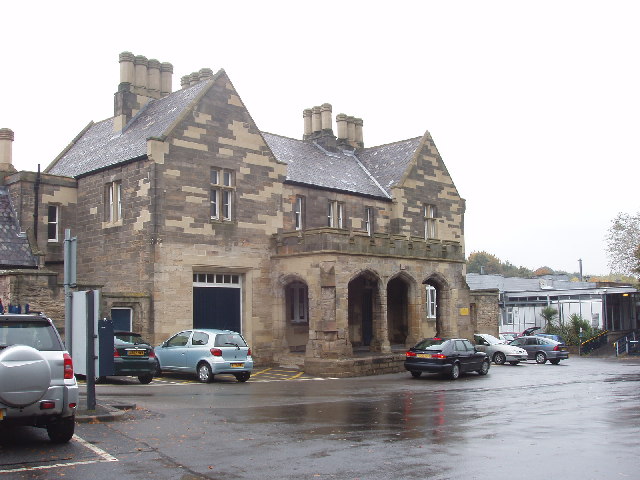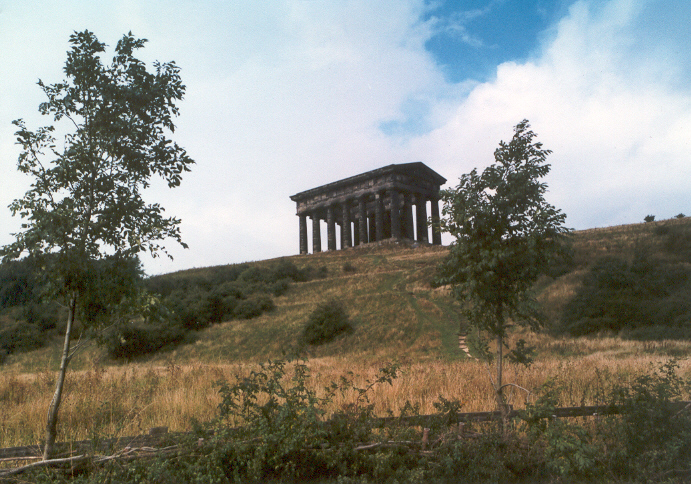|
Durham Railway Station
Durham is a railway station on the East Coast Main Line, which runs between and . The station, situated south of Newcastle, serves the cathedral city of Durham in County Durham, England. It is owned by Network Rail and managed by London North Eastern Railway. It is managed and served frequently by London North Eastern Railway (as a stop on the East Coast Main Line). It is also served by CrossCountry, TransPennine Express and Northern trains. Durham is a through station with two platforms, located north of the city centre, on a hill. South of the station, the railway line is elevated on a viaduct. After a renovation between 2006 and 2008, the original stone station building is now the ticket hall. History The city of Durham has been served by four stations, only one of which survives today: *Shincliffe (called Shincliffe Town from 1861): located in nearby Shincliffe, this station was built in 1839 and was served by the Durham and Sunderland Railway, using rope haula ... [...More Info...] [...Related Items...] OR: [Wikipedia] [Google] [Baidu] |
County Durham
County Durham ( ), officially simply Durham,UK General Acts 1997 c. 23Lieutenancies Act 1997 Schedule 1(3). From legislation.gov.uk, retrieved 6 April 2022. is a ceremonial county in North East England.North East Assembly â€About North East England. Retrieved 30 November 2007. The ceremonial county spawned from the historic County Palatine of Durham in 1853. In 1996, the county gained part of the abolished ceremonial county of Cleveland.Lieutenancies Act 1997 . Retrieved 27 October 2014. The county town is the of |
Durham Sunderland Line
Durham most commonly refers to: * Durham, England, a cathedral city and the county town of County Durham * County Durham, an English county *Durham County, North Carolina, a county in North Carolina, United States * Durham, North Carolina, a city in North Carolina, United States Durham may also refer to: Places Australia *Durham, Queensland, an outback locality in the Bulloo Shire of Queensland *Durham Ox, Victoria * Durham Lead, Victoria, a locality in the City of Ballarat Canada *Durham, Nova Scotia *Durham, Ontario, a small town in Grey County, Ontario *Durham County, Ontario, a historic county *Regional Municipality of Durham, a regional government in the Greater Toronto Area of Ontario **Durham (electoral district), a federal electoral district in Durham Region **Durham (provincial electoral district), a provincial electoral district in Durham Region *Durham Bridge, New Brunswick *Durham Parish, New Brunswick * Durham-Sud, Quebec (also known as South Durham) United Kingdom * ... [...More Info...] [...Related Items...] OR: [Wikipedia] [Google] [Baidu] |
Beeching Cuts
The Beeching cuts (also Beeching Axe) was a plan to increase the efficiency of the nationalised British Rail, railway system in Great Britain. The plan was outlined in two reports: ''The Reshaping of British Railways'' (1963) and ''The Development of the Major Railway Trunk Routes'' (1965), written by Richard Beeching and published by the British Railways Board. The first report identified 2,363 stations and of railway line for closure, amounting to 55% of stations, 30% of route miles, and 67,700 British Rail positions, with an objective of stemming the large losses being incurred during a period of increasing competition from road transport and reducing the rail subsidies necessary to keep the network running. The second report identified a small number of major routes for significant investment. The 1963 report also recommended some less well-publicised changes, including a switch to the now-standard practice of containerisation for rail freight, and the replacement of some ... [...More Info...] [...Related Items...] OR: [Wikipedia] [Google] [Baidu] |
British Railways
British Railways (BR), which from 1965 traded as British Rail, was a state-owned company that operated most of the overground rail transport in Great Britain from 1948 to 1997. It was formed from the nationalisation of the Big Four British railway companies, and was privatised in stages between 1994 and 1997. Originally a trading brand of the Railway Executive of the British Transport Commission, it became an independent statutory corporation in January 1963, when it was formally renamed the British Railways Board. The period of nationalisation saw sweeping changes in the railway. A process of dieselisation and electrification took place, and by 1968 steam locomotives had been entirely replaced by diesel and electric traction, except for the Vale of Rheidol Railway (a narrow-gauge tourist line). Passengers replaced freight as the main source of business, and one-third of the network was closed by the Beeching cuts of the 1960s in an effort to reduce rail subsidies. On privatis ... [...More Info...] [...Related Items...] OR: [Wikipedia] [Google] [Baidu] |
Penshaw
The village of Penshaw , formerly known as ''Painshaw'' or ''Pensher'', is an area of the metropolitan district of the City of Sunderland, in Tyne and Wear, England. Historically, Penshaw was located in County Durham. Name and etymology The name ''Penshaw'' was recorded in the 1190s as ''Pencher'' and is of Brittonic origin. The first element is ''pen'', meaning 'hill' or 'summit' and the second ''*cerr/*carr'' - 'stone, hard surface'. Features Penshaw is well known locally for Penshaw Monument, a prominent landmark built in 1844 atop Penshaw Hill, which is a half-scale replica of the Temple of Hephaestus in Athens. Owing to its proximity to Durham City, the area was allocated a Durham postcode, DH4, which forms part of the Houghton-le-Spring post town. It lies about three miles north of Houghton-le-Spring, just over the River Wear from Washington. It borders Herrington Country Park and is surrounded by a series of villages: Herrington, Shiney Row, Biddick, Coxgreen an ... [...More Info...] [...Related Items...] OR: [Wikipedia] [Google] [Baidu] |
Sunderland Railway Station
Sunderland is a railway station on the Durham Coast Line, which runs between Newcastle and Middlesbrough via Hartlepool. The station, situated south-east of Newcastle, serves the port city of Sunderland in Tyne and Wear, England. It is owned by Network Rail and managed by Northern Trains. Since 31 March 2002, the station has also been served by the Tyne and Wear Metro. History Earlier stations Opening in 1836, the first railway passenger services to Sunderland were provided by the Durham and Sunderland Railway Company, initially linking the then port town with Haswell and Hetton-le-Hole. Approaching from the south along the coast, the terminus, known as ''Town Moor'' was located near South Dock. The Durham and Sunderland Railway Company slowly extended their route towards the intended terminus in Durham – though the eventual terminus, which opened in 1839, was located outside the city at . The line reached Durham in July 1893, when the North Eastern Railway opened the ex ... [...More Info...] [...Related Items...] OR: [Wikipedia] [Google] [Baidu] |
Team Valley
Team Valley is a trading estate located in Gateshead. It is home to the Retail World retail park, with many large, international companies are based in the area's trading estate. In 2017, there were approximately 700 companies on the estate, employing approximately 20,000 people. The residential area known as the Teams is adjacent to Dunston. History In the 1930s, the Government decided to spend nearly £2 million on this part of Gateshead, establishing the Team Valley Trading Estate as a well-planned industrial environment. The architect in charge was William Holford, with Hugh Beaver as chief engineer. It included a central headquarters, now used by English Partnerships, a bank, post office, and some modestly scaled industrial buildings, as well as some smaller industrial units for start-up ventures. These facilities were laid out along a wide central artery, known as ''Kingsway'', almost long. Work on the estate began in May 1936, and the first factory opened in the Octob ... [...More Info...] [...Related Items...] OR: [Wikipedia] [Google] [Baidu] |
Tursdale
Tursdale is a hamlet in County Durham, England. It is situated in rural landscape about two miles to the west of Coxhoe, two miles North of Cornforth and around five miles south of Durham. It is part of the civil parish of Cassop-cum-Quarrington. It is ideally located for speedy access to both Durham city, the A1M, and Teesside via Sedgefield. Despite its close proximity to many local amenities and towns, residents enjoy the peaceful lifestyle of living in a semi-rural location, with lovely views across the fields. Tursdale currently consists of a single street of housing, Ramsay Street, a school house and a small 4 home conversion of the former school which closed in the 1960s. A second street, School Street, a row of bungalows and other dwellings were demolished in the 1960s and early ’70s. Standalone Farm, whose final remnants probably went at about the same time, may once have been a moated house of some antiquity. All houses in Tursdale, other than farms, were originall ... [...More Info...] [...Related Items...] OR: [Wikipedia] [Google] [Baidu] |
Durham To Bishop Auckland Line
The Durham to Bishop Auckland Line was a railway line originally built by the North Eastern Railway (NER) to provide rail transport access to coal mines in West County Durham. It closed under the Beeching Axe to passenger traffic in May 1964, and freight in 1968. Today it forms the major part of the Brandon to Bishop Auckland rail trail. Background After the opening of the Stockton and Darlington Railway (S&DR) in 1825 to transport coal from the Witton Park Colliery to Newport on the River Tees, railways had been expanding across County Durham to provide coal mine owners with access to cheap economic transport. Bishop Auckland gained its first rail link in 1842, when the S&DR backed Bishop Auckland and Weardale Railway (BA&WR) gained the powers via an Act of Parliament to build a railway line from the S&DR's station at via Bishop Auckland and Witton-le-Wear into Crook, County Durham. After the completion of Shildon Tunnel, the BA&WR erected a permanent station in the town ... [...More Info...] [...Related Items...] OR: [Wikipedia] [Google] [Baidu] |
North Eastern Railway (UK)
The North Eastern Railway (NER) was an English railway company. It was incorporated in 1854 by the combination of several existing railway companies. Later, it was amalgamated with other railways to form the London and North Eastern Railway at the Grouping in 1923. Its main line survives to the present day as part of the East Coast Main Line between London and Edinburgh. Unlike many other pre-Grouping companies the NER had a relatively compact territory, in which it had a near monopoly. That district extended through Yorkshire, County Durham and Northumberland, with outposts in Westmorland and Cumberland. The only company penetrating its territory was the Hull & Barnsley, which it absorbed shortly before the main grouping. The NER's main line formed the middle link on the Anglo-Scottish "East Coast Main Line" between London and Edinburgh, joining the Great Northern Railway near Doncaster and the North British Railway at Berwick-upon-Tweed. Although primarily a Northern ... [...More Info...] [...Related Items...] OR: [Wikipedia] [Google] [Baidu] |
River Browney
The River Browney is a river in County Durham, England, and the largest tributary of the River Wear. The River Browney rises from a spring in Head Plantation, on the eastern slope of Skaylock Hill, about a mile south east of Waskerley. The spring rises approximately from a tributary stream to the River Wear, in an area of moorland, forestry and springs, and of disused coal mines, quarries and mineral railway lines, remnants of an industrial past. Running eastwards towards Lanchester, the river skirts to the south of the village. Continuing eastwards past Langley Park and Witton Gilbert, the river then turns south and skirts the western edge of Durham. The Browney is joined by the River Deerness north of Langley Moor and finally joins the Wear to the south of Durham, close to Sunderland Bridge. Until the last ice age, the Browney entered the River Wear just north of Durham City, in Pelaw Woods. The Browney was contaminated by local industry, particularly lead and coal mini ... [...More Info...] [...Related Items...] OR: [Wikipedia] [Google] [Baidu] |
A690 Road
The A690 is a road in County Durham running from Sunderland in the east through Durham to Crook. Route Sunderland section Throughout the Sunderland section it is known as either ''Durham Road'' or ''New Durham Road'', and is one of the major routes in and out of the city. A single carriageway section runs from the city centre to a large roundabout at the Barnes. The road then climbs a steep hill toward High Barnes, alongside the Bede site of the Sunderland College before becoming dual carriageway. Beyond a set of traffic lights at the ''Prospect Hotel'', the road remains dual carriageway, but the inside lane is a 'no car lane'. (In early 2009 the ''Prospect Hotel'' was demolished to make way for a new Lidl store.) The road then climbs another hill, becoming single carriageway, with the Farringdon estate to the east and the Thorney Close estate to the west. A down hill stretch leads into the East Herrington and then on toward the A19 fly-over. Just after the A19 intersectio ... [...More Info...] [...Related Items...] OR: [Wikipedia] [Google] [Baidu] |


.jpg)






